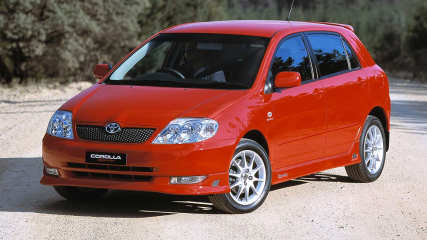Used Toyota RAV4 review: 1995-2011
By Ewan Kennedy · 07 May 2012
When launched in October 1994, the Toyota RAV4 was a cute and cheeky 4WD. Over the years it expanded in size and from the latest model in February 2006 has become positively staid – sounds like the typical human life cycle doesn’t it!In the ‘teenage’ years of its life cycle, the funkiest of all RAV4s arrived in January 1998, but barely lasted two years on the market. Though called Cabriolet by Toyota, it is in fact an old-style soft-top. The roof is reasonably easy to pull down and erect, but we still recommend a bit of practice at home before you set out on a topless trip on a cloudy dayThe great majority of Toyota RAV4s have a two or four-door station wagon body. The former is on a shorter wheelbase than the latter, so misses out on both rear-seat space and luggage carrying capacity.The RAV4 isn't designed to conquer the great Aussie outback, Toyota has plenty of other 4WDs and SUVs capable of dong just that, but it is a lot more competent than you might expect. Good ground clearance, big wheels and handy approach, departure and ramp angles mean it can take on rocks, ruts and rough stuff with plenty of verve. The short-wheelbase is, naturally, better than the LWB if you want to get serious off-road.These little Toyota SUVs use what are virtually car tyres and don’t have a low-range transfer case. Better tyres can make it just perfect on the beach.The RAV4’s first engine was a modern 2.0-litre four-cylinder unit that gives better than average performance for its class. The engine was extensively modified at the beginning of 1998 to give it a broader spread of torque. The four-cylinder engine was increased in size to 2.4 litres in 2003.From October 2007 a V6 engine option with the capacity of 3.5 litres joined the fray. It goes without saying the V6 has plenty of grunt, but it can be on the thirsty side at times.You have a choice between a five-speed manual and a four-speed automatic transmission in most models. The V6 comes only with a five-speed auto. The four-speed automatic is a modern unit that works well and doesn’t take too much edge off the performance, but many computers now provide five or six forward ratios.Toyota has been number one in the Australian automotive market for a number of years. So it has dealers in almost all areas of Australia, even those which are ignored by other big players in our market. So getting spares and repairs isn't likely to be a hassle.Dealers in the most remote zones are more likely to carry spare parts for LandCruisers than for the RAV4s. Nonetheless, you aren’t likely to have to wait for more than a few days for parts to be shipped to the bush from one of the major cities.Insurance is generally in the low to moderate range and there doesn't seem to be a huge variance in premium prices between them.WHAT TO LOOK FORThe Toyota RAV4 is built to a high standard but it’s still wise to have a full inspection after doing your own check up. Most RAV4s never go off road, but look closely for panel and underbody damage, just in case.Scratches in the paint and and/or the door sills and lower body corners are tell-tale signs a RAV4 has come into contact with solid objects, perhaps only bushes and similar shrubbery. But it all costs money to have rectified.If you come across sand in the underbody, try it for a salty taste. RAV4s appear to be well rust proofed but salt water really rips into steel if it gets half a chance. Check the condition of the trim, especially in a soft-top as the latter may have been caught out in the rain or even driven in the surf - again check for that salty smell or taste.Listen and feel for loose components in the transmission system that have been abused in off-road driving. The engine should start first time every time, and idle smoothly even when completely cold. If there is smoke from the exhaust under hard acceleration the engine may be in a bad way.If a manual gearbox is reluctant to go down from third to second when the change is hurried, trouble could be brewing. Automatic transmissions which have had a hard life may be reluctant to change and could be slow at engaging a drive gear from Neutral or Park.CAR BUYING TIPSilly as it may sound, beware the 4WD that has been off-road. So few do any real work these days that it’s easy to find one that’s never been off sealed surfaces.









